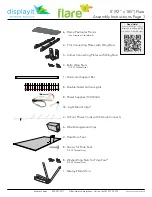
7
e
AC power switch
Turns the AC power on and off.
• I : on
䡬
: off
NOTE:
• You need to turn on the stand-by button on the front
panel to turn on the monitor after turning on the AC
power switch.
r
Composite signal input/output terminals
(VIDEO A, VIDEO B)
Input (IN) and output (OUT) terminals for the
composite signals of the NTSC, PAL, and B/W
(50 Hz/60 Hz).
NOTES:
• NTSC and PAL are switched in the “COLOR SYSTEM.”
☞
“COLOR SYSTEM” on page 12
• The IN and OUT terminals are bridge-connected (auto
termination).
t
Analog audio signal input/output terminals
(AUDIO A, AUDIO B)
Input (IN) and output (OUT) terminals for the analog
audio signals.
NOTE:
• The IN and OUT terminals are bridge-connected.
y
REMOTE (external control) terminals
Terminals for controlling the monitor by an external
control.
☞
“How to Use the External Control” on pages 14 and 15
u
DC switch
Turns the DC power on and off.
• I : on
䡬
: off
NOTES:
• You need to turn on the stand-by button on the front
panel to turn on the monitor after turning on the DC
switch.
• The monitor consumes the battery even while the
monitor is on stand-by. To save battery life, turn off the
DC switch on the rear panel.
• While you operate the monitor with the DC power
supply, the built-in degaussing circuit does not work. If
the monitor has become magnetized, switch the power
supply to AC so that the built-in degaussing circuit
works or use an external degausser.
En_04-07_TM-1011G.p65
06.2.14, 22:32
7






































